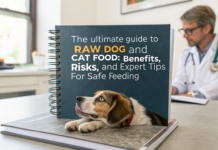Last Updated on March 31, 2024 by Dogs Vets
Preventing Cross-Feeding Between Your Pets
Preventing cross-feeding between pets, especially in households with both cats and dogs, is essential to ensure each pet receives the nutrition they require for their specific dietary needs.
Here are strategies to prevent cross-feeding and ensure your pets maintain their appropriate diets:
1. Separate Feeding Areas
Create distinct feeding areas for each pet. This can mean feeding your pets in different rooms or at least several feet apart if space is limited. Physical separation helps prevent one pet from accessing the other’s food.
2. Stagger Feeding Times
Feed your pets at different times. By staggering feeding times, you can closely monitor each pet’s eating habits and ensure they’re only consuming their food. Once a pet has finished eating, immediately remove any leftover food before the next pet’s mealtime.
3. Use Pet Gates or Barriers
For persistent cross-feeders, using pet gates or barriers during meal times can be effective. This allows each pet to eat in peace without the temptation of wandering over to the other’s food bowl.
4. Elevate Food Bowls
Cats are generally more comfortable and willing to jump to higher places than most dogs. Placing the cat’s food bowl on a higher surface, such as a countertop or a cat feeding station, can prevent dogs from reaching it while still being accessible to the cat.
5. Supervised Feeding
If feasible, supervise your pets during meal times. This way, you can quickly intervene if one tries to eat from the other’s bowl. Supervised feeding also reinforces to your pets that they are expected to eat only their food.
6. Train Your Pets
With patience and consistent training, you can teach your pets to respect each other’s feeding areas. Use commands they understand and rewards for compliance to reinforce these boundaries over time.
7. Automatic Feeders
For tech-savvy pet owners, automatic feeders can offer a solution. Some advanced models can be programmed to open only for a pet wearing a specific RFID tag, ensuring that only the intended pet can access the food inside.
8. Keep a Routine
Maintaining a consistent feeding routine helps pets understand their own feeding times and expectations, reducing the likelihood of cross-feeding curiosity.
9. Address Food Guarding Behavior
If one pet is guarding both food bowls, it may be necessary to address the behavior directly through training or consultation with a veterinarian or animal behaviorist. Food guarding can lead to stress and aggression, impacting the well-being of both pets.
Conclusion
Preventing cross-feeding in multi-pet households requires a combination of strategic planning, supervision, and sometimes a bit of creativity.
By ensuring your pets are fed separately and understand where and when they should eat, you can maintain their health and harmony in your home.
Each pet’s nutritional needs are important, and by preventing cross-feeding, you’re taking a vital step in caring for their well-being.
FAQ’S
Here are the top 5 questions and answers on this topic to help you manage your multi-pet household effectively:
1. Why is it important to prevent cross-feeding between dogs and cats?
Answer: Dogs and cats have significantly different nutritional needs.
Cats are obligate carnivores and require certain nutrients, such as taurine, that are not necessary in the same quantities for dogs. Allowing cross-feeding can lead to nutritional deficiencies or excesses, potentially causing health issues.
For example, dog food lacks essential nutrients for cats and can lead to deficiencies, while cat food is too rich for dogs and can cause digestive upset or obesity.
2. What are some effective ways to prevent my dog from eating my cat’s food?
Answer: To prevent your dog from eating your cat’s food, consider feeding them in separate rooms or using a baby gate to restrict access.
You can also place the cat’s food bowl on a higher surface, like a countertop or a specially designed cat feeding station, which the dog cannot reach. Another strategy is to supervise meal times to intervene if necessary and establish a strict feeding schedule to discourage scavenging.
3. Can I train my pets to only eat their food? How?
Answer: Yes, pets can be trained to eat only their food through consistency and positive reinforcement. Use commands they already know, like “leave it,” when they approach the other pet’s food. Reward them with treats or praise when they obey.
Consistent training over time can teach pets to respect each other’s feeding spaces.
4. What should I do if my pets are already used to eating each other’s food?
Answer: If your pets are already accustomed to eating each other’s food, gradually reintroduce them to their own diets. This might involve supervised feeding sessions where you gently guide each pet to their own bowl and prevent them from wandering.
Consider implementing the strategies mentioned earlier, like feeding in separate areas, to establish new routines and boundaries.
Consultation with a veterinarian may also provide additional strategies tailored to your pets’ specific behaviors.
5. How can automatic feeders help prevent cross-feeding, and are they effective?
Answer: Automatic feeders can be highly effective in preventing cross-feeding, especially those designed to open only for a pet wearing a specific RFID tag or microchip.
This technology ensures that only the intended pet has access to the food inside the feeder. These feeders are particularly useful for pets with different dietary needs or when the pet owners are away from home.
However, they may require some initial training for pets to get used to them, and not all pets might be comfortable with the noise or movement of the feeder.
References:
Fact Check
We strive to provide the latest valuable information for pet lovers with accuracy and fairness. If you would like to add to this post or advertise with us, don’t hesitate to reach us. If you see something that doesn’t look right, contact us!

















